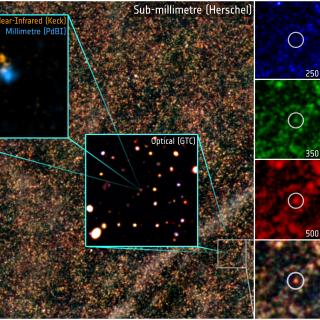Bibcode
Fynbo, J. P. U.; Christensen, L.; Geier, S. J.; Heintz, K. E.; Krogager, J. -K.; Ledoux, C.; Milvang-Jensen, B.; Møller, P.; Vejlgaard, S.; Viuho, J.; Östlin, G.
Referencia bibliográfica
Astronomy and Astrophysics
Fecha de publicación:
11
2023
Revista
Número de citas
3
Número de citas referidas
3
Descripción
We report on further observations of the field of the quasar Q 1218+0832. Geier et al. (2019, A&A, 625, L9) presented the discovery of the quasar resulting from a search for quasars reddened and dimmed by dust in foreground damped Lyman-α absorbers (DLAs). The DLA is remarkable by having a very large H I column density close to 1022 cm−2. Its dust extinction curve shows the 2175 Å bump known from the Local Group. It also shows absorption from cold gas exemplified by C I and CO molecules. For this paper, we present narrow-band observations of the field of Q 1218+0832 and also use an archival Hubble Space Telescope (HST) image to search for the galaxy counterpart of the DLA. No emission from the DLA galaxy is found in either the narrow-band imaging or in the HST image. In the HST image, we could probe down to an impact parameter of 0.3 arcsec and a 3-σ detection limit of 26.8 mag per arcsec2. In the narrow-band image, we probed down to a 0 arcsec impact parameter and detected nothing down to a 3-σ detection limit of about 3 × 10−17 erg s−1 cm−2. We did detect a bright Lyman-α emitter 59 arcsec south of Q 1218+0832 with a flux of 3 × 10−16 erg s−1 cm−2. We conclude that the DLA galaxy must be located at a very small impact parameter (< 0.3 arcsec, 2.5 kpc) or it is optically dark. Also, the DLA galaxy most likely is part of a galaxy group.
The reduced GTC spectrum is available at the CDS via anonymous ftp to cdsarc.cds.unistra.fr (ftp://130.79.128.5) or via https://cdsarc.cds.unistra.fr/viz-bin/cat/J/A+A/679/A30
Proyectos relacionados

Formación y Evolución de Galaxias: Observaciones Infrarrojas y en otras Longitudes de Onda
Este grupo desarrolla varios proyectos extragalácticos en diferentes rangos del espectro electromagnético utilizando satélites y telescopios en tierra para estudiar la evolución cosmológica de las galaxias y el origen de la actividad nuclear en galaxias activas. En el aspecto instrumental, el grupo forma parte del consorcio internacional que ha
Ismael
Pérez Fournon